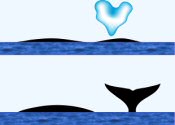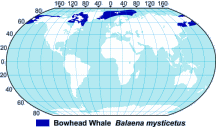Bowhead Whale
CLASS: Mammalia
ORDER: Cetacea
SUBORDER: Mysticeti
FAMILY: Balaenidae
GENUS: Balaena
SPECIES: mysticetus
The bowhead whale, formerly known by Yankee whalers as the Greenland right whale, is a taxonomic relative of the right whale. It received its name from the high, arched upper jaw that somewhat resembles the shape of an archer's bow. Bowheads live at the southern edges of the Arctic ice during winters and move into leads through broken & melting ice during summers. Bowhead whales have been an important subsistence item for arctic native hunters for centuries, with the blubber (muktuk in Alaskan Inuit), muscle, & certain internal organs as valuable energy-rich food; the baleen used to make implements, baskets (from the hairy fringes), & works of art; and the bone used for housing construction, handles of tools, etc.
Physical Descriptinn
Found only in Arctic and sub-arctic waters, the bowhead whale has a massive body protected from the icy waters by a layer of blubber up to 2 feet thick. Its head is immense; it makes up nearly one-third of the bowhead's total body length. Its mouth can be as long as 16 feet (4.9 m), 12 feet (3.7 m) high, and 8 feet (2.4 m) wide and its tongue weighs about 1 ton (907 kg). In profile, a bowhead whale's head is triangular in shape, which may be an adaptation that enables the whale to break through the ice to breathe. Bowhead whales have a high bridge (termed the "stack") on which sit the nostrils, and with this are able to smash through ice that is 1-2 feet thick to breathe, presumably as they visually follow long cracks and valleys we now know to mark the bottom of the ice. There are 2 blowholes located at the highest point of the head that send 2 bushy, V-shaped blows 13 feet (4 m) in the air. While swimming, only the bowhead whale's triangular head and rounded back show above the surface of the water.

Surface Characteristics
Color
Bowhead whales are blue-black in color, except for a variable amount of white on the lower jaw. A series of irregular black spots are usually found on the white patch, and a few stiff hairs grow at the front of both the upper and lower jaws. In addition, there may be some white markings on the belly, and a gray-to-white band just forward of the fluke (tail). This "penduncle patch" near the tail turns whiter and larger with age, and very old bowhead whales may have all-white tails.
Fins and Fluke
The bowhead whale's broad back has no dorsal fin, a characteristic of the genus. The deeply-notched flukes of a mature bowhead whale can measure 25 feet (7.6 m) from tip to tip. Flippers are broad and paddle shaped, about 6 feet (1.8 m) in length.
Mating and Breeding
Adult males reach physical maturity at 50 feet (15 m) and may weigh in excess of 60 tons (54,431 kg). Sexual maturity is reached at 38 feet (11.6 m). Adult females are slightly larger than males at both physical and sexual maturity. Maximum length exceeds 60 feet (18.3 m).
Feeding
Bowhead whales feed on planktonic organisms including copepods, amphipods, euphausiids, and various other crustaceans. They consume about 2 tons (1800 kg) of food each day. As a baleen whale, it has a series 325-360 fringed overlapping plates of baleen hanging from each side of the upper jaw, just outside where teeth might otherwise be located. These plates consist of a fingernail-like material called keratin that frays out into fine hairs on the ends inside the mouth near the tongue. The plates are dark gray-to-black and are the longest baleen of any whale, measuring up to 14 feet (4.3 m) in length and 12 inches (30 cm) in width. While feeding, a bowhead whale skims through the water with its mouth open. As water flows into the mouth and through the baleen, prey are trapped on the inside near the tongue to be swallowed.
Mating and Breeding
Mating takes place in late spring or early summer, and the calves are 11-18 feet (3.5-5.5 m) long at birth. Calving is every 3 to 4, but occasionally with intervals as long as 7 years. Gestation length has not been confirmed but is probably 13 to 14 months, potentially longer. Calves are born with a thick layer of blubber which helps them survive in freezing water immediately after birth. The calf nurses for about 9 to 12 months.

Range Map
Distribution and Migration
Migration is seasonal, and movements are determined by retreating or advancing ice. Always close to the edge of the Arctic icepack, bowhead whales of the Chukchi-Beaufort-Bering Sea follow it south to the Bering Sea in winter northeast to the Beaufort Sea, and northwest to the Chukchi Sea. They feed in the Arctic Ocean in summer. On the northward migration, bowhead whales are often accompanied by beluga whales, who follow them through the leads in the ice. Segregation by age and sex is evident during certain phases of the migration. Worldwide, bowhead whales are found in the western Arctic (Bering, Chukchi, and Beaufort Seas), the Canadian Arctic (Baffin Bay, Davis Strait, and Hudson Bay), the Okhotsk Sea (in Russia, between the mainland, the Kamchatka Peninsula, and the Kuril Islands), and Spitsbergen westward to Greenland in the far north Atlantic Ocean. The Spitsbergen stock may be extinct.
Natural History
Bowhead whales usually travel alone or in small groups of up to 6 animals. Larger congregations may be seen in the feeding grounds. These whales are slow swimmers, and will retreat under the ice when they are alarmed. Their sight and hearing are excellent, and they vocalize with low moans that at times occur in discrete sequences of sound representing simple song. These may be mating displays, but this has not been investigated. Their only known predator, besides man, is the killer whale. There is increasingly good evidence that bowhead whales can live for well over 100 years, and they may be the longest-lived mammal on Earth.
Status
Commercial whalers discovered the bowhead whale as early as 1611 in the eastern Arctic and in 1848 in the western Arctic. Unregulated commercial whaling continued into the early 1900s, reducing the bowhead whale populations to the point of extinction. Bowhead whales have been completely protected from commercial whaling since 1946; Eskimos have hunted "the whale" for centuries. In accordance with International Whaling Commission (IWC) rules, Eskimos are legally allowed to hunt an allocated number of bowhead whales each year for food and oil. Hundreds of bowhead whales were taken each year in the late l800s and early 1900s, and great profits were made from the sale of oil and baleen. A single bowhead whale could yield up to 100 barrels of oil and 1500 pounds of baleen or "whale bone." In 1859 the price of whale oil dropped dramatically because of substitutes made from petroleum then discovered in western Pennsylvania. Hunting continued for the baleen alone and the rest of the animal was discarded. Baleen was used for such things as corset stays, buggy whips, watch springs, skirt hoops, fishing rods, and umbrella ribs. The use of baleen became unnecessary in the early 1900's as a result of the development of spring steel. At present, the number of bowhead whales of the Chukchi-Beaufort-Bering Sea is estimated to exceed 8,000, those of the eastern Canadian Arctic and of the Okhostsk Sea in far east Russia are in the hundreds.
Bibliography
- Burns, J.J., J.J. Montague and C.J. Cowles. 1992. The Bowhead Whale. Special Publications No. 2. The Society for Marine Mammalogy, Special Publication No. 2, Lawrence, KN.
- Heide-Jørgensen, M.P. 2006. Greenland's Winter Whales: The Beluga, the narwhale, and the bowhead whale. Illiniusiofik.
- Jefferson, T.A., M.A. Webber, R.L. Pitman. 2015. Marine Mammals of the World: A Comprehensive Guide to their Identification, 2nd edition. Elsevier/AP.
Acknowledgements
Illustrations courtesy Uko Gorter, copyright ©2017 all rights reserved.
FACT SHEETS MAY BE REPRINTED FOR EDUCATIONAL OR SCIENTIFIC PURPOSES
|



